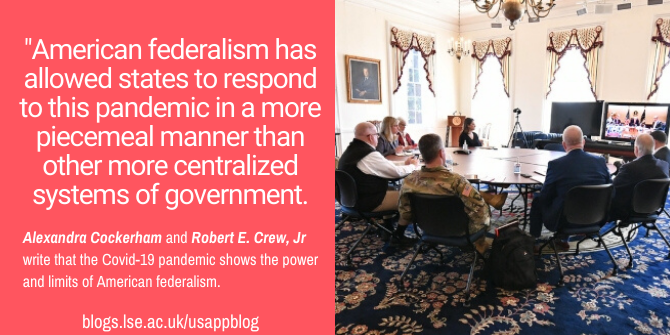This post first appeared on The LSE US Centre’s daily blog on American Politics and Policy
American federalism allows different responses to policy challenges, and the nation’s response to the Covid-19 pandemic is no exception. When looking at any sort of crisis, the chief executive of a state or municipality is often the leader in responding given their unilateral authority to act quickly (often via executive orders). However, this does not mean that all US chief executives have responded in the same manner to Covid-19. In fact, across the US states, governors have responded differently than the president, and mayors have responded differently from even governors of their own state. With regards to public policy, the federal government sets the minimum threshold but states are free to have stricter guidelines or even laws and the same is true for mayors within a state.
Given the global nature of this pandemic, it is natural to compare the United States’ response to that of other governments and more specifically, democracies around the world. However, when examining the US’s reaction to Covid-19 we must look beyond the response of the federal government and instead concentrate on the actions of governors and even mayors to get a true sense of how exactly the US is responding to Covid-19. In late January, Donald Trump declared a public health emergency, and prevented most foreigners who had recently visited China from entering the US. However, a national emergency was not declared until mid-March. Since then, Trump’s administration has taken economic action to try to alleviate the effects of the pandemic and has released federal guidelines on how to keep schools and communities safe. However, many governors have taken steps far beyond these federal guidelines and have written more stringent policies into law (often through executive order). Given the nature of the problem they faced- a single disease – the governors responded to this crisis in relatively similar fashion. Most closed schools, imposed lockdown measures that limit social contact, including restrictions on private non-essential businesses, closing bars and restaurants or limiting dine-in restaurants to carry out only, implementing a curfew for private citizens, etc.
There were differences, however, in the timing of implementation, in the comprehensiveness of restrictions and in the aggressiveness with which governors pursued their goals. These differences were, in turn driven by the dates when the virus surfaced in a state, by the severity of the attack and by the nature of the state’s economy. Most governors acted alone but the Governors of New Jersey, Connecticut and New York jointly declared a state of emergency and called for identical restrictions in their intertwined jurisdictions. Governors in states where the virus surfaced early and where the numbers affected were large – New York, Washington and California – acted early (and New York on January 30) were aggressive in issuing comprehensive restrictions and repeatedly called on the US President for quicker action. Many of these actions were subsequently diffused to other states. Other governors, such as Kay Ivey of Alabama, took early action (on March 6) by assembling a Coronavirus Task Force but did so little to follow up that her own Lieutenant Governor tried to sound an alarm and said she was “scarcely visible” in the effort. Governors in large, diverse states and in states particularly reliant on tourism and the sales tax – Texas and Florida – were hesitant to issue orders affecting all areas of the state equally or to adopt the comprehensive policies affecting the entertainment and leisure industries that were common in most states.

“White House Call” by Maryland GovPics is licensed under CC-BY-2.0
Governors in small, rural states – South Dakota, Nebraska – took very limited action. Pete Ricketts in Nebraska limited gatherings to groups of ten, but took no other action and Krista Noem in South Dakota declared a state of emergency but then simply closed schools for two weeks. While rare, partisanship has occasionally reared its head. When the Democratic Governor of North Carolina, Roy Cooper, closed all bars and restaurants in the state, the Republican Lieutenant Governor challenged his authority to do so and called the closing a bad idea. Of course, as with many state level policies, there has been some degree of policy diffusion where bigger more populous states, which happen to be some of the states hit the hardest with the pandemic, have set the precedent for other states to follow.
As this pandemic unfolds the federal government has made attempts to try to coordinate efforts across states and localities. Last week the president spoke directly to governors through a video conference, asserting that his administration is looking to provide guidelines specifically for state and local government with regards to “maintaining, increasing or relaxing social distancing and other mitigation measures” to the corona virus epidemic. Furthermore, the Trump administration hopes to utilize data in sorting counties into different risk categories. American federalism has allowed states to respond to this pandemic in a more piecemeal manner than other more centralized systems of government. For better or worse (depending on the criteria) it also allows for the government to respond to the conditions within each state or city based on variables ranging from the level of risk of infection to perhaps less life-threatening concerns such as the economic conditions within a state. However, despite the federal government’s attempts to centralize, it remains the prerogative of the states and localities whether or not to enforce more stringent measures.

Dr. Alexandra Cockerham is an Assistant Teaching Faculty in the Interdisciplinary Social Sciences Program.

Dr. Robert E. Crew, Jr. is Professor of Political Science and Director of the graduate Program in Applied American Politics at Florida State University.
The feature image is from YouTube.

One Comment Add yours